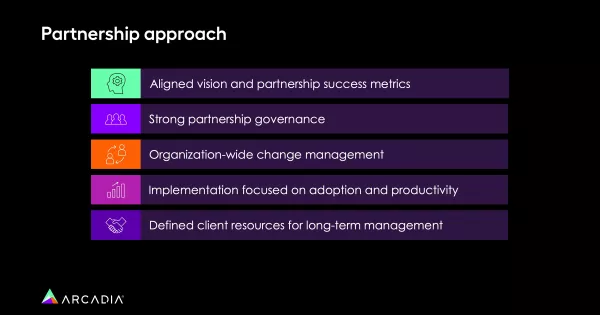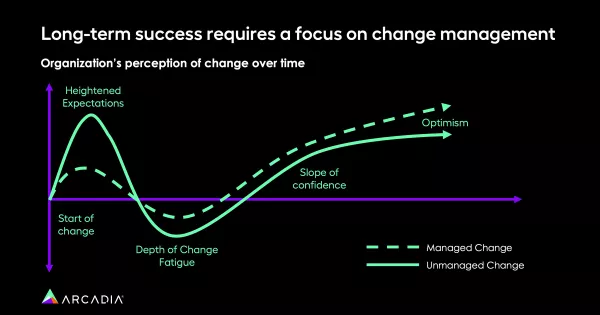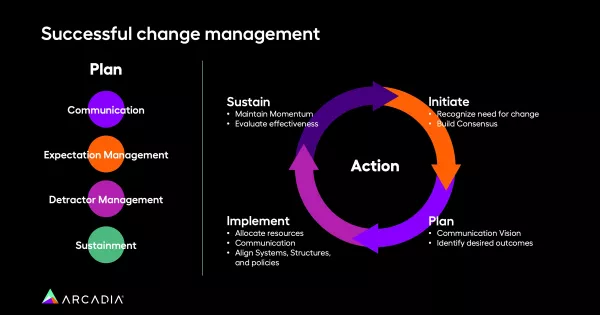Make a good first impression: Keys to achieve long-term success in healthcare data analytics
The road to happy end-users and improved performance can be rocky, but with forethought, implementing a data platform can be a smooth transition.
A healthcare data analytics platform is a powerful tool, but that doesn’t mean it’s a magic bullet — implementing and utilizing technology in healthcare requires forethought, finesse, and leadership. Arcadia Chief Operating Officer Mike Tiffany and former Senior Director of Implementation Rob Leslie outline how organizations can navigate the process from acquisition to implementation with confidence, following a few key steps to avoid disaster and achieve better performance and outcomes.
Data analytics and healthcare orgs: Partners in performance

“Achieving long-term success in a healthcare data platform effort is extremely difficult,” Leslie says. “One of the things that’s really important initially is starting off with the concept of having a partnership — thinking beyond a standard vendor-client relationship that you might have leveraged in the past.”
A big component of this is a clear, shared vision. A vendor needs to understand the “why” of what a client wants to accomplish just as precisely as the organization they’re working with. It helps to have an executive champion who can communicate this goal across employees and stakeholders. With that common objective, everyone’s aiming for the same target.
“A key, respected strategic executive — like a medical director or a physician — should be able to evangelize this throughout the organization,” Leslie explains. “That’s going to drive a lot more alignment and help manage potential bumps in the road over the course of initial implementation.”
Consider, too, how those goals will be measured. Knowing specific success factors, and surfacing those with everyone involved, will help keep things on track.
An ounce of forethought is worth a pound of workflow trouble
Establishing partnership governance early on is a similar safeguard against derailing progress.
“Governance can’t be a conversation that starts post go-live. It needs to be a conversation that happens at kickoff,” Leslie says.
In reality, this means asking “who owns what?” at a detailed level. The clearer certain roles, responsibilities, and tasks are delineated, the less opportunity there is for important work to fall through the cracks.
A change management strategy for success

Change management should be top of mind at the beginning of any collaboration between a vendor and an organization. Whether they’re beloved or riddled with issues, there’s a good chance that employees are used to the reports and processes they’re using now. With a large change on the horizon, organizations (and the vendors they work with) should consider how best to smooth that transition, whether it’s a newly formatted report or a workflow that’ll prompt changes in the examination room. Expecting conflict (or bracing for it just in case) will help both parties navigate it if and when it arises.
On the brink of implementation, users often have high expectations, which then plummet when they’re deep in the learning process, navigating new technology that’s unfamiliar. Ideally, their confidence in the tool should rise again. As a graph, you might see a sharp spike, a sharp plummet, and then a slowly, steadily ascending line that remains stable.
“It’s important to take on change management at the very beginning of a relationship so that you can manage the expectations of the organization and all the different individuals that will interact with the platform,” Tiffany explains.
The higher the initial “spike,” the further a data analytics platform has to fall in the estimation of its users. Alternately, a clear picture of what to expect and how the process will unfold helps new customers level-set and prepare for whatever learning curve lies ahead.
“Set guardrails,” Tiffany says. “Get people excited about the project for the right reasons.”
Similarly, be forthright about potential difficulties.
“Be honest if there’s going to be a pain period before you get the benefits of a particular change,” he says.
Now arriving at implementation station
Once you’ve mapped out the changes ahead and agreed on what you want to accomplish, it’s time to begin implementation. The shared vision and partnership governance should be guideposts that help direct the implementation process.
This is a good time to establish and highlight the support resources a vendor can offer. These will be handy at go-live, but they’re also important for the day-to-day use of an analytics program long after it’s launched. Users of a platform should know where to surface issues for help resolving them, or who to ask when a particular question arises. This might mean hiring more support staff if you’re a vendor, or auditing what support is available at present.
From there, a continuous improvement cycle will ensure satisfaction on both sides. Implement, sustain, initiate, plan, and repeat ad infinitum, because even if your initial roll-out is ironclad, unexpected obstacles will inevitably come up.

As managers and executives plan for additional improvements, they should communicate these endeavors throughout the wider organization, clearly set expectations, make a point to address detractors’ feedback, and sustain current processes.
From first impressions to year-end achievements, data analytics drives results
Embracing new technology can be a challenge no matter an organization’s size or ambitions, but setting strategy as early as possible will help vendors and partners ensure a great first impression. Mapping out the road ahead — from anticipated disruptions to steep learning curves — will keep the process navigable and lessen anxiety around a major change.
Want to equip your team with data that drives results? Reach out to us to learn more about how we're empowering healthcare leaders.
